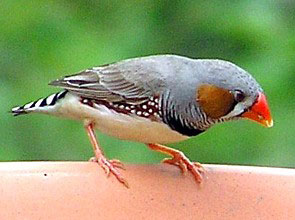 |
| Zebra Finch (Taeniopygia guttata) (Photo credit: Wikipedia) |
Latin names are always hard to pronounce and difficult to remember but due to the varying local names for birds in different countries, they can often be the best way to identify a bird conclusively. For the finches, most of the species encountered in bird keeping come from two main families - the estrildidae finches and the Fringillidae finches.
Fringillidae finches are often referred to as 'true finches' or Old World finches, despite some of them being found in Hawaii and one family in the Arctic fringes. They are most common in Europe and the family name comes from the Latin name for one of their distinctive members, the Chaffinch (Fringilla coelebs). Familiar faces in this family depend on where you live but birds such as the European greenfinch, goldfinch and the siskins are all members, as well as one of the most commonly kept birds - the canary.
Estrildidae finches are often referred to as New World or Exotic Finches, though again this isn't a totally accurate name as some are found in Old World tropics areas. Most of these species are from warmer climates however so when kept in the Northern Hemisphere, often need heat to survive. Included in the family is another very commonly kept bird, the Zebra Finch, along with waxbills, Firefinches and the mannikins or munias.
Nesting choices
Birds choose their nesting location and type of nest by some internal standard that we humans can only try to anticipate - this means that there is no guarantee that a bird will choose the nest box it is 'meant' to. As a rule, however, estrildid finches tend towards closed nest boxes made from wood or plastic that either has a small hole in the front or an open section. Fringillidae finches will often make use of a nesting pan, a half cup often made from plastic or wicker, which they will add some nesting material too.
If you are breeding finches in a large cage or an aviary, they will often build their nests where they please. You can offer a host of beautiful ready-made nesting facilities and they will build a nest in the corner on a ledge or behind where the boxes stand so don't be surprised if the nest box remains empty and chicks appear from some strange location.
In breeding cages, they have less option and often an external nest is used so that room inside the cage isn't lessened by it. Nesting pans can be attached to cage bars and sometimes fake plants are used to hide it so that the bird has the illusion of being in a tree.
The breeding process
Every species of bird has its own courtship rituals, breeding preparations and specific requirements to start the process. Some, such as the Zebra finch, merely need somewhere to nest, some nesting material and a mate to get started and will breed whenever they feel like it. Others wait for a specific breeding season, which will often fall into line with the breeding season of the wild birds in the country - normally the warmest times of the year. The Canaries are an example of this as are goldfinches and greenfinches.
Eggs are usually white for the estrildid finches and shades of blue-green for the Fringillidae finches, the latter being larger as are most of the birds. Incubation periods also vary as do the number of chicks but around two to three weeks incubation is generally the norm. Once the chicks hatch, some being completely bald while others have small tufts of hair, they are blind for around a week and remain in the nest for three to four weeks. When they leave the nest or fledge, they will be dependent on their parents for a week or two more as they learn to feed themselves.
Problems
This is, of course, a simplification of the process that may not be as easy as this. Birds can abandon nests with eggs and with chicks, other factors can disturb them or the chicks die in the eggs and the birds realise this. Chicks can fall from nests or contract illnesses that mean they die at some point. But saying all of this, there is nothing better than peeking into a nest and seeing a host of new life, even if there have been hurdles along the way.
In my experience, the key to breeding finches is to let them get on with it as much as possible and think of what they would need in the wild. While most birds have never seen their native environment, their instincts are still strong. Plants, either real or fake, are a big factor, as is providing live food such as mealworms to some species. Do plenty of research before buying birds to understand what you need to provide them for them to be happy - if they aren't happy, they will never breed. And even then, things can still go wrong. But when it goes right, it is a wonderful experience and one you will quickly become addicted to.
For more information about the different species of finches and how to breed them please see my articles at https://thefinchweekly.wordpress.com/
Article Source: EzineArticles |

No comments:
Post a Comment